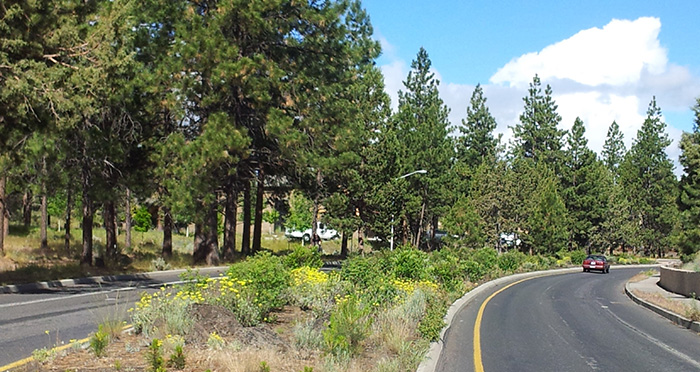(Photo above: Sustainable streetscape planting | courtesy of Katrina Langenderfer Landscape Architecture)
Sustainability is a trendy concept right now. Maybe you have heard the phrase — sustainable landscape design – but what does that really mean?
The American Society of Landscape Architects defines sustainable landscapes as “responsive to the environment, re-generative, and can actively contribute to the development of healthy communities. Sustainable landscapes sequester carbon, clean the air and water, increase energy efficiency, restore habitats, and create value through significant economic, social and, environmental benefits.”
Landscape Architects in the High Desert are leading the charge on applying sustainable design principles to both site planning and design. Common local sustainable design applications include water-wise and native plantings, high efficiency irrigation, ecological stormwater management and native and salvaged materials selection.
Water-wise landscape design solutions are on the rise across the Central Oregon. Water-wise landscapes encourage the use of native and drought resistant plants. Implementation of native plantings can offer many benefits. First and foremost, native plants when selected based on site conditions, have lower water requirements that non-natives.
They are less susceptible to environmental pests and disease, and provide much needed habitat for wildlife. For example, pollinator gardens have recently been added to some Bend parks, including Stone Creek Park, which will be built this spring. One of the key plants in pollinator gardens is milkweed, which is a critical food source and habitat for the monarch butterfly.
Sustainable landscapes look to reduce or eliminate high maintenance lawns. In our High Desert climate, lawns consume large amounts of both water and fertilizer. While eliminating or limiting lawns within commercial or residential sites may seem like a scary proposition, a landscape architect can help you find unique design solutions to meet your site’s needs. A reduction in lawn on a site can be beneficial to not only your environmental footprint, but also your pocketbook. It will leave the green in your wallet, since you will see a reduction in your water bill, and in mowing and landscape maintenance costs.
In combination with the “right” planting selections, sustainable landscapes implement thoughtful irrigation practices. High efficiency irrigation systems with adjustable drip lines are a popular irrigation water application method here in Central Oregon. Inline irrigation systems conserve water by allowing plants to be watered directly at the soil surface, reducing water loss and overspray, particularly on windy days.
Sustainability can also play a role in the treatment of stormwater on your site. Two ecological stormwater management solutions are rain gardens and bioswales, which provide ways to treat rainwater runoff from impervious areas. They are typically depressions in the landscape that receive water directed from impervious surfaces, such as driveways, walkways and roofs. They are designed to allow rainwater to soak into the ground naturally. And through the use of soils, plants and naturally occurring microbes, they help to filter and remove pollutants from the stormwater runoff, before it enters the watershed or groundwater. Benefits include not only pollutant removal, but also wildlife habitat creation.
Site materials selection is one more sustainable design strategy. Salvaged materials, such pavers and old concrete slabs can be reused to create hardscapes, such as patios, plazas and paths. The use of native local stone, rocks, gravels and soils, are more cost effective because they reduce the cost of transport to your site and they blend seamlessly into the character of the native landscape.
Sustainable landscape practices have no boundaries! They can be applied to new site developments or older site renovations, and the development scale can range from individual residential homes to commercial and urban sites, such as parks, plazas, and streetscapes.
Designing sustainable landscapes might seem a bit overwhelming, but local Landscape Architects are here to help. By choosing to implement sustainable landscape design strategies, you will receive the benefits of reduced water usage and landscape maintenance savings, and the added bonus of environmental benefits to your Central Oregon community! Landscape Architects use a creative design approach and intimate knowledge of local environmental conditions to work with you to create unique and functional landscape spaces. These sustainable landscapes will meet your needs, provide environmental benefits, and surpass your expectations!
Katrina Langenderfer, PLA, ASLA
Principal Landscape Architect, Katrina Langenderfer Landscape Architecture
Co-Chair High Desert Section, Oregon Chapter, American Society of Landscape Architects
Kat@KLLandArch.com
Katrina (Kat) has lived and worked in Central Oregon for over 13 years. When not designing parks and open spaces across the region, trail running in the High Cascades, mountain biking with her husband Steve and taking her dog Porter standup paddle boarding at Elk Lake.





